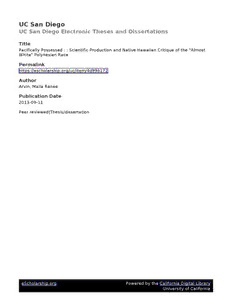
Pacifically Possessed: Scientific Production and Native Hawaiian Critique of the "Almost White" Polynesian Race PDF
Preview Pacifically Possessed: Scientific Production and Native Hawaiian Critique of the "Almost White" Polynesian Race
UC San Diego UC San Diego Electronic Theses and Dissertations Title Pacifically Possessed : : Scientific Production and Native Hawaiian Critique of the "Almost White" Polynesian Race Permalink https://escholarship.org/uc/item/4d99b172 Author Arvin, Maile Renee Publication Date 2013-09-11 Peer reviewed|Thesis/dissertation eScholarship.org Powered by the California Digital Library University of California UNIVERSITY OF CALIFORNIA, SAN DIEGO Pacifically Possessed: Scientific Production and Native Hawaiian Critique of the "Almost White" Polynesian Race A dissertation submitted in partial satisfaction of the requirements for the degree Doctor of Philosophy in Ethnic Studies by Maile Renee Arvin Committee in charge: Professor Ross Frank, Chair Professor Denise Ferreira da Silva, Co-chair Professor Catherina Gere Professor Adria Imada Professor Andrea Smith Professor K. Wayne Yang 2013 Copyright Maile Renee Arvin, 2013 All Rights Reserved. The Dissertation of Maile Renee Arvin is approved, and it is acceptable in quality and form for publication on microfilm and electronically: ________________________________________________________________ ________________________________________________________________ ________________________________________________________________ ________________________________________________________________ ________________________________________________________________ Co-Chair ________________________________________________________________ Chair University of California, San Diego 2013 iii DEDICATION For Kalani Awo: He ʻōpū hālau. A heart as big as a house. And for the entire Awo ʻohana: Me ke aloha pauʻole. iv TABLE OF CONTENTS Signature Page ................................................................................................................... iii Dedication .......................................................................................................................... iv Table of Contents .................................................................................................................v List of Figures .................................................................................................................. viii Acknowledgements ............................................................................................................ ix Vita ................................................................................................................................... xiv Abstract of the Dissertation ...............................................................................................xv Introduction ..........................................................................................................................1 Chapter 1: The Polynesian Problem and its Genomic Solutions .......................................45 Part 1: Defining the Polynesian Problem ...............................................................49 1.1.1: From Who to Whose: Origins, Identity, and Possession of the Indigenous Pacific ......................................................................................53 1.1.2: Polynesia Through the Christian Lens of Degeneration ..................58 1.1.3: Heirlooms of the Aryan Race ..........................................................65 Part 2: (Un)Mapping Humanity: Genetic Sameness and Mixture in the Pacific ...75 1.2.1: Genetically "Solving" the Polynesian Problem ...............................76 1.2.2: The Hawaiian Genome Project ........................................................85 Chapter 2: "Still in the Blood": Past and Present Configurations of the "Part-Hawaiian" ..........................................................................................................................................103 Part 1: Eugenic Thinking About Native Hawaiian Betterment ...........................109 2.1.1: Eugenics Pedagogy in Hawaiʻi: Uldrick Thompson's Hopes for the Hawaiian "Remnant" ...............................................................................109 2.1.2: Sullivan's "Two Types" of Polynesians .........................................121 v Part 2: Leveraging Blood and Whiteness .............................................................133 2.2.1: Polynesian Blood and the Pre-requisite of Whiteness ...................135 2.2.2: Calling the Law on "Native Hawaiians with a Capital N" ............140 Chapter 3: Re-envisioning "Hybrid" and "Hapa": Race, Gender and Indigeneity in Hawaiʻi as Racial Laboratory ..........................................................................................157 Part 1: Hybrid Hawaiian Types: Native Hawaiian Women in Hawaiʻiʻs Racial Laboratory ............................................................................................................162 3.1.1: The Racial Laboratory of Romanzo Adams and the Chicago School of Sociology .............................................................................................165 3.1.2: Hybrid Hawaiian Girls ...................................................................175 Part 2: Hapa and Whole .......................................................................................185 3.2.1: Kip Fulbeck's Vision of Hapa as a "Whole" New Race ................190 3.2.2: Re-constellations of Asian Settlers, Haoles Settlers, and Native Hawaiians .................................................................................................199 Chapter 4: Beyond Recognition: Native Hawaiians, Human Rights, and Global Indigenous Identities ........................................................................................................211 Part 1: Polynesia and Hawaiʻi in the Science of Race After World World II .....215 4.1.1: The Polynesian Problem as Anti-Racist Example .........................215 4.1.2: "Tropical Democracy" and the Science of Stabilizing Mixed Race ..................................................................................................................227 Part 2: Reframing Recognition: Indigenous Rights and Relationships in Oceania and Beyond ..........................................................................................................241 4.2.1: Polynesian / Pacific / Pacific Islander ............................................245 4.2.2: Indigenous / Non-Self-Governing Territory ..................................251 4.2.3: Native American / Alaska Native / Idle No More .........................263 Conclusion .......................................................................................................................272 vi Bibliography ....................................................................................................................280 vii LIST OF FIGURES Figure 2.1: "Indonesian Type," "A Hawaiian Fisherman" and "Polynesian Type." Louis Sullivan, "New Light on the Races of Polynesia," Detach from Asia, 1923. ..................129 viii ACKNOWLEDGEMENTS I began this project on the land of the Kumeyaay people in La Jolla, California, and as I finish it, I write on the land of the Abenaki people in Hanover, New Hampshire. In living and working on their lands, without holding any substantial relationship with, much less the permission of the Kumeyaay and Abenaki, I have incurred a debt I may never be able to repay to these peoples. I want to say here not exactly thank you (as gratitude is inappropriate and inadequate in regards to something taken, not given) but I will not forget. I am immensely grateful for the support and fellowship I have received over the last several years, which sustained and brought this project to life. I would like to express my gratitude to the Ford Foundation, whose Pre-doctoral Fellowship supported three years of my graduate study. I must also thank the Newberry Library in Chicago, whose Frances C. Allen Fellowship, a research fellowship for Indigenous women, provided a rich foundation to this work. I am especially grateful to the Newberry's Scott Stevens and Diane Dillon for their strong support of my scholarship. I also thank the staff of the Bishop Museum Library and Archives in Honolulu for their help with my research there, as well as Betty Kam in the Cultural Resources department. Further, I am grateful to Meiji University in Tokyo, Japan, whose affiliation in the summer of 2012 gave me an air-conditioned place to write in the sweltering humidity of a Tokyo summer. I appreciate the kindness of Mari Armstrong-Hough and Yoshi Hananoi, in Meiji's School of Political Science and Economics, for allowing me that privilege. ix
